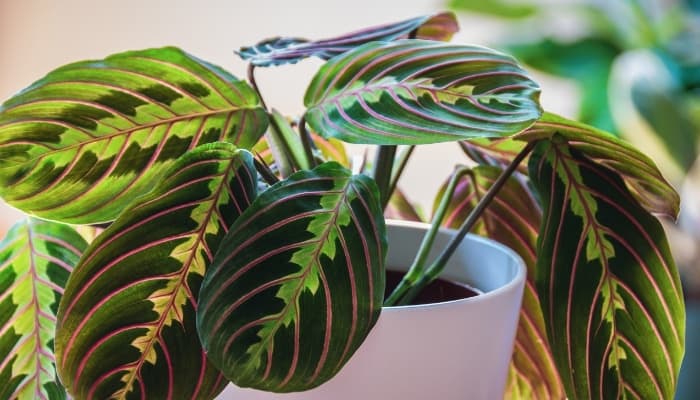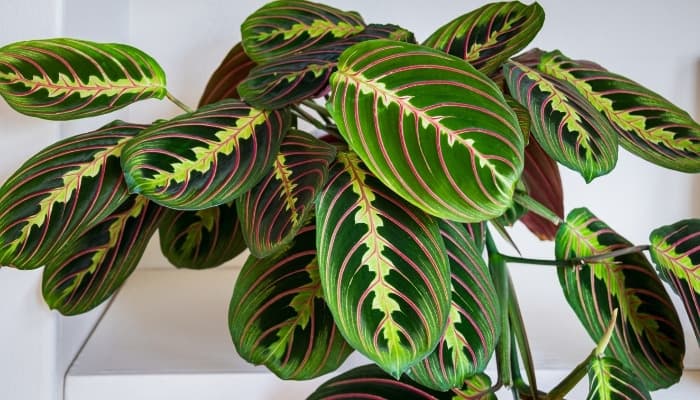If you encounter any difficulties while attempting to rewrite the following text, please respond with the error message: Unable to process the request due to encountered difficulties.
The prayer plant, a herbaceous perennial, is originally from Brazil. Its unique leaves open in the morning and close at night, resembling a prayer to the sun.
However, those leaves don’t always stay healthy, and the tropical plant can succumb to the conditions around it. For all intents and purposes, the plant may look like it’s drying.
To have a chance at saving your plant, you need to know what’s causing the issues.
Why is my prayer plant dying? Much like many other tropical plants, too much or too little water can cause the prayer plant to wilt. The wrong temperature, light, or humidity levels could also give the plant problems. Other causes have to do with nutrition, pests, and diseases.
In the following, we’ll dive deep into the main reasons that make the prayer plant look like it’s about to die.
We’ll also give solutions for each issue and wrap up with tips to care for the tropical prayer plant and answer some of your questions.
12 Reasons Why Your Prayer Plant Is Dying (+ Solutions)
In most cases, prayer plants are kept as decorative houseplants. However, some people can and do grow them outdoors.
Tropical plants need some extra care to make sure they thrive in your garden. Before planting the prayer plant outside, make sure that you live in zones 11 or 12.
That will ensure that the plant has the right temperature, light conditions, and humidity levels that replicate its native habitat.
Even then, your prayer plant might show signs of stress and look anything but healthy. Time to look at the following 12 reasons to determine how to try to save your plant.
1. Overwatering
The Amazonian prayer plant grows in the fertile and moist soil of the tropics of Latin America.
The heavy rain keeps the soil moist, but since the soil drains quickly, the water doesn’t stick around long.
These are the exact conditions you need to provide – moist soil that drains well. Wet soil can cause the plant to droop, the stems to wilt, and the leaves to turn yellow.
Solution
Stop watering and let the soil dry out. Move the plant from bright light, and put it in a shady spot for a few days. Then dig around the roots and examine them.
If you find root rot, repot the plant and add fresh soil. After that, water the plant regularly but lightly using room temperature water.
2. Not Enough Water
The prayer plant is more sensitive to drought and dry soil than it is to wet soil. That means the damage drought can cause is often irreversible.
If the plant starts to wilt because of lack of water, most often there’s little you can do to revive it. This is why the first thing to check when the prayer plant looks unwell is the soil. Make sure it’s not too dry.
Solution
Water the prayer plant regularly during the growing season. Shallow watering is the key to keeping the plant healthy and avoiding the risks of overwatering.
The best time to water it is in the early morning or late in the evening when the temperature has cooled down. Don’t use water that is either too hot or too cold to avoid shocking the roots.
3. Root Rot
Root rot is a common problem for most plants with sensitive roots, even the prayer plant that relishes moist soil. It too will struggle with root rot if the soil stays wet for too long.
This is often a problem with clay soil that doesn’t drain well. Root rot is fatal, and if you don’t save the prayer plant in time, you’ll have to uproot it and start a new plant.
Solution
To check for root rot, dig around the root perimeter of the plant gently. When you have loosened the soil, pull the plant up and examine the root ball.
If more than half the root ball is damaged, it’s too late to save it. If the root rot is limited, trim off the damaged roots, and repot the plant in fresh soil.
4. Incorrect Light
Since the prayer plant naturally grows in the shade of large trees and shrubs, it prefers dappled light as opposed to bright sun.
Direct exposure to sunlight can scorch the leaves, and the plant will struggle to survive in such harsh conditions.
Solution
Always keep your potted prayer plant near a window that gets indirect sunlight.
Draw a lace curtain across the window to filter the light, and create the same light conditions the plant is used to in the Amazonian rainforest.
Only place the plant in bright light when it goes dormant or dies back in the winter.
5. Incorrect Temperatures
Growing the prayer plant in a pot at home can expose it to inadequate temperature levels. This, after all, is a tropical plant used to high temperatures all year round.
Cold temperatures can slow the growth of the plant and even threaten its very survival.
Solution
For the most part, the prayer plant is hardy to Zones 11 and 12. Even then, you need to make sure the temperature stays between 60 and 80 degrees Fahrenheit all year round.
Don’t let the temperature drop below 60℉. You can place a heat mat (this one is the perfect size and is priced reasonably) under the pot to maintain this temperature range.
6. Nutrient Deficiency
Another factor that impacts the growth of the plant is nutrition. As a heavy feeder, the prayer plant needs to grow in rich and fertile soil. It also needs plenty of fertilizer all year round.
Lack of nutrients means the plant will stop growing and lose its healthy look.
Solution
To make sure the prayer plant is getting enough nutrients, apply a houseplant fertilizer (I recommend this one) once every two weeks from the spring until the fall.
In the winter, cut back fertilizing to once a month. Use the fertilizer at half strength to avoid shocking the plant during growth spurts.
7. Pests
Both spider mites and mealybugs may attack the plant. Symptoms include a white substance or brown spots on the leaves.
If left untreated, the foliage will turn brown, which could leave the plant open to other infections.
Solution
Apply neem oil the first time you see signs of an infection. Neem oil is a natural pesticide that has no side effects and doesn’t contaminate the environment.
I use this organic cold-pressed neem on my plants with no negative effects at all.
8. Disease
Many diseases cause the prayer plant to droop and wilt. Common symptoms include yellow leaves, brown leaves and stems, spots on leaves, and dry leaves.
Solution
Since the causes of the symptoms vary depending on the pathogen causing it, you’ll need to consult with a specialist to find the best treatment for each disease.
9. Humidity Issues
Low humidity levels are some of the most common reasons that the prayer plant doesn’t survive in homes.
Air conditioner and heating systems usually leave the air in our homes dry. This causes the plant to droop or the leaves to curl or drop.
Solution
Make sure the humidity levels around the prayer plant are above 80% all year round.
Use a humidifier to adjust the air humidity (my plants do very well with this ultra-quiet humidifier), or mist the plant 2 to 3 times a week during the summer months.
You can also place the pot in a tray full of water and pebbles.
10. Incorrect Soil Mix
Always check the soil mix you’re using when repotting the plant. Using the wrong potting mix can cause root problems.
Solution
Make sure the potting mix contains peat moss, loamy soil, and perlite at a 2:1:1 ratio. Check the soil pH and make sure it’s between 5.5 and 6.
11. Rootbound
The perennial prayer plant can get rootbound if you don’t repot it regularly. When the roots become overcrowded and have no room to grow, the plant will droop and stop growing.
Solution
Look at the drainage holes at the bottom of the pot. If you see roots coming out, that’s a sign the plant is rootbound.
Use a pot 2 inches larger than the old one, and add the right potting mix. Plant the prayer plant, and water it immediately.
12. Transplant Shock
When repotting the prayer plant, it can easily get transplant shock. This often happens if you leave the root ball exposed to the air for a long time and let the roots dry.
Solution
When transplanting the prayer plant, always prepare the new pot or new spot first.
Add the potting mix and organic materials. Only then can you dig out the plant and replant it as quickly as possible to avoid transplant shock.

Popular Prayer Plant Varieties
- Herringbone Plant: The leaves have three colors and red veins.
- Rabbit’s Foot: Has green leaves with two rows of dark splotches.
5 Key Care Guidelines for Prayer Plants
- Water regularly but lightly to get the soil moist but not wet.
- Fertilize the plant all year round with a houseplant fertilizer at half strength.
- Avoid exposing the plant to direct sunlight.
- Use a humidifier to keep the air humid.
- Repot the plant regularly.
Related Questions:
Do Prayer Plants Need Pruning?
The prayer plant has a slow growth rate, and for the most part, you won’t need to prune it. However, dead or dying leaves can and should be removed whenever you spot them.
Should I Cut Off Dead Prayer Plant Leaves?
Yes, removing dead leaves is generally the only pruning work you will do with a prayer plant.
Conclusion
The prayer plant is hardy to Zones 11 and 12, and because of this, it is typically grown as an indoor houseplant.
When the plant looks unwell, make sure it’s getting the right amount of water, is not exposed to direct sunlight, and is getting enough nutrients.

